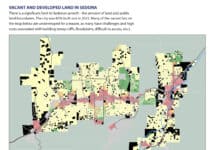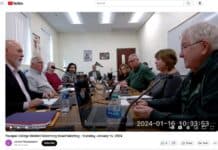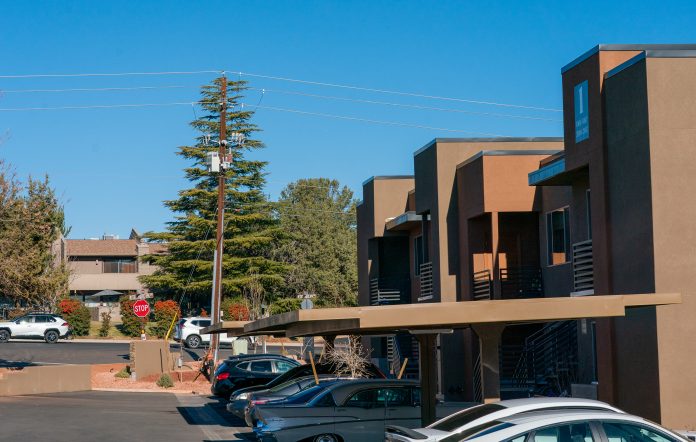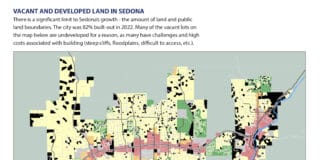The lack of affordable — or available — workforce housing in Sedona has steadily gone from being a problem to becoming a crisis.
That feeling was loud and clear on Dec. 9, as the Sedona City Council was presented a draft of the Affordable Housing Needs Assessment and the development of the draft five-year housing action plan.
According to a city report, for the last several years, council has identified the need for workforce housing as one of its highest policy priorities. Sedona’s Community Plan identified housing diversity as one of six major outcomes to achieve by 2020. That outcome specifically called for housing types that “provide options for all ages and income levels by using innovative public policies and programs, and nurturing partnerships with private developers.”
Rick Merritt, a consultant with Elliot D. Pollack and Company, led the discussion, which was originally scheduled to take place in March but was reportedly delayed due to COVID-19.
The purpose of the study is to provide the city and its Housing Assessment Advisory Committee with the initial findings of the existing conditions analysis and housing-gap assessment.
According to the report, nearly 58% of the renters in Sedona are cost burdened, paying more than 30% of their household income on rent. The lack of affordable units most affects those households earning less than $50,000, including service workers, teachers, and critical service employees such as police and fire fighters.
The study shows the root of the housing problem is threefold.
■ The first is increasing house prices. At the end of the first quarter of 2019, the median single-family home cost in Sedona was $562,500, more than double the state’s average cost.
■ Short-term vacation rentals have played a part as well.
Many long-term rentals have since been turned into short-term rentals. This has decreased available affordable housing while driving up the cost of those long-term rentals that remain.
■ Finally, Sedona only has 257 units within what would be considered traditional apartment complexes and only 211 occupied single family attached units or townhomes. This accounts for less than 10% of the city’s total housing units, well below the national average of around 30%.
A 2017 census shows that nearly 75% of those who work in Sedona commute in from other areas of the Verde Valley due to costs and a lack of available housing. That figure, which may have increased the past three years, holds true for the city’s 160 employees as well. Despite an average salary of $60,370, just 20% of the city staff live in Sedona or the Village of Oak Creek. City leaders have discussed providing a housing stipend for those city employees who are deemed critical, such as police officers.
Merritt said a demographic summary shows that Sedona is expected to see an increase of 1,600 jobs over the next decade.
“That 1,600 job growth is a really important factor because that creates your demand for housing,” he said. “People want to come here to work, they want to live somewhere close to work and that is a major demand factor for the future in terms of your affordable housing.”
A survey of more than 400 people working in Sedona by the consultant showed that 60% of respondents said they would live in Sedona if there was affordable housing. A similar survey of employers showed they wer e concerned about the lack of housing in Sedona, which has often led to a constant turnover of staffing.
The Affordable Housing Action Plan is prepared with the understanding of the limitations facing Sedona in the expansion of its affordable housing stock, including:
■ The lack of developable land in the city and the cost of land.
■ The lack of multifamily units in the city, which creates a significant impediment for providing affordable housing to persons currently working in the community.
■ The cost of construction in Sedona, which is among the highest in the state.
■ The small size of multi-family projects typically built in Sedona. Larger projects provide economies of scale that can be used to offset a high cost environment.
■ Limited access to capital due to the perceived limited employment base in the city by lending institutions.
■ The size of the demand for affordable units in the city at 1,500 units will require Sedona to be active in its approach to implementing the plan.
The Action Plan objectives include encouraging development of affordable housing units that meet the needs of low and moderate income households. In order to be effective, Merritt said this objective requires the active recruitment of affordable housing developers by the city. In addition, a regional, collaborative approach to the affordable housing issue should also be considered for the entire Verde Valley.
Merritt also said the city should incentivize the inclusion of affordable units in private development and increase resources to support production of affordable housing. Finally, the city should monitor the increase in demand and loss of affordable housing units in the community, particularly mobile homes built before 1976.
The housing topic will be included in the council’s retreat set for early February. The consensus from the council was to hire a housing manager for the city but there was no specific direction as to when that should occur.






















